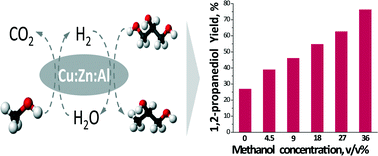Glycerol hydro-deoxygenation aided by in situ H2 generation via methanol aqueous phase reforming over a Cu–ZnO–Al2O3 catalyst†
Abstract
A tandem catalytic cycle of methanol aqueous phase reforming–glycerol hydro-deoxygenation targeted to 1,2-propanediol formation under inert conditions is investigated. The H2 needed for glycerol hydro-deoxygenation is provided in situ via methanol reforming. The effects of reaction time, temperature, methanol concentration and system pressure were investigated over a Cu : Zn : Al bulk catalyst. The catalytic results showed that 1,2-propanediol selectivity and yield depend on reaction temperature and reaction time combination. Higher methanol concentrations favor glycerol hydro-deoxygenation towards the desired pathway, resulting in a significant increase in 1,2-propanediol selectivity. Under optimum reaction conditions (t = 1 h, T = 250 °C, 36 v/v% CMeOH + 9 v/v% CGLY, 1.0 < PN2 < 3.5 MPa), glycerol was almost fully converted (95.9%), with 79.4% selectivity (76.2% maximum yield) to 1,2-propanediol. Upon catalyst reuse, the Cu : Zn : Al catalyst showed satisfactory stability. An initial loss of activity (35.8%) was observed, which was ascribed to Cu agglomeration; however, catalyst performance was improved and stabilized after the third run, possibly due to Cu re-dispersion. It is proposed that metallic Cu0 efficiently catalyzes glycerol hydro-deoxygenation, while methanol reforming is mainly catalyzed by metallic Cu0 and facilitated by the interaction of Cu0 with ZnO–Al2O3 structures.


 Please wait while we load your content...
Please wait while we load your content...